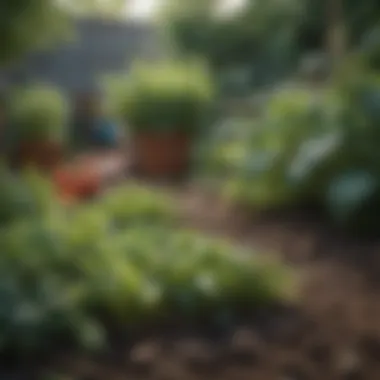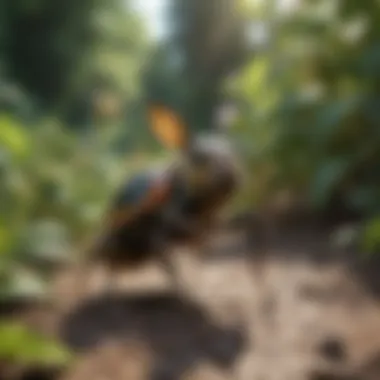Michigan Planting Guide: Mastering Local Flora Cultivation


Intro
Michigan boasts a rich diversity of flora, influenced by its unique climate and soil conditions. Understanding the specific needs of plants in this region will enhance gardening efforts. This guide will explore the planting requirements tailored to Michigan. The objective is to assist both novice gardeners and experienced horticulturists. Armed with this knowledge, one can cultivate an effective planting plan.
Fascinating Facts About Michigan Flora
Unique Characteristics
Michigan's plant life is notable for several reasons. The state has various ecosystems, including wetlands, forests, and grasslands. These contribute to a broad range of native species. Some plants have adapted to thrive in specific soil types found in the region, such as sandy or clay soils. Furthermore, Michigan experiences varied climate zones, from humid continental to subarctic. This affects the range of plants that can be successfully cultivated.
Extraordinary Abilities
Many native plants have evolved unique adaptations to survive Michigan's changing seasons. For instance, the common milkweed features a deep root system that helps it endure drought. Other species, like the eastern red cedar, demonstrate resilience against harsh winters. These adaptations ensure survival and provide essential ecosystems services, such as supporting pollinators and maintaining soil health.
Planting Timelines
Planting in Michigan requires awareness of seasonal changes. Each type of plant has a prime planting time. Understanding these timelines enhances the likelihood of success.
- Spring: Ideal for sowing seeds of vegetables and annual flowers. Soil temperatures begin to rise, fostering germination.
- Early Summer: Best for planting heat-loving crops like tomatoes and peppers.
- Fall: Many perennials can be planted in early fall. This allows them to establish roots before winter.
Adhering to these timelines can significantly improve outcomes.
Native Species
Utilizing native plants is crucial for sustainable gardening. These species are already adapted to Michigan's environment. They require less maintenance and are more resistant to local pests. Some notable native plants include:
- Black-eyed Susan: Bright and hardy, this flower attracts pollinators.
- Purple Coneflower: Known for its medicinal properties and ability to thrive in drought conditions.
- Joe-Pye Weed: Its tall stature and vibrant blooms support various wildlife.
Soil Considerations
Understanding the soil types in Michigan helps in selecting appropriate plant species. Soil health can influence plant growth and resilience.
- Clay Soil: Retains moisture well but may hinder root growth. Choose plants like daylilies or willows that tolerate these conditions.
- Sandy Soil: Drains quickly and warms up faster. Suitable plants include lilacs and sedums.
- Loamy Soil: Fertile and balanced; it supports a wide range of plants.
Testing soil pH and texture can further refine plant choices.
Pest Management Strategies
Proper pest management is essential for a flourishing garden. Here are common strategies for Michigan gardeners:
- Companion Planting: Pairing plants can deter pests. Marigolds are known to ward off nematodes.
- Organic Pesticides: Consider neem oil or insecticidal soaps to manage infestations.
- Regular Monitoring: Inspect plants frequently for early signs of pest activity.
Implementing these strategies will promote a healthier garden environment.
Seasonal Considerations
Michigan experiences a broad range of weather patterns. Each season presents unique challenges and opportunities for gardeners.
- Spring Delays: Late frosts can impact planting schedules; monitoring forecasts is key.
- Summer Droughts: Ensure consistent watering during hot spells. Mulching can help retain soil moisture.
- Fall Preparation: Begin necessary preparations for winter, including mulching and plant protection.
Understanding the climate and being aware of seasonal changes can greatly benefit gardening efforts in Michigan.
Preamble to Michigan's Planting Environment
Understanding the planting environment in Michigan is vital for anyone looking to cultivate flora successfully. The state's diverse climate and soil types play a major role in determining what plants will thrive and how to maintain them effectively. Recognizing these factors enables gardeners to create a suitable ecosystem for their plants, ultimately leading to a more fruitful gardening experience. This section explores key elements that can profoundly influence gardening decisions.
Understanding Michigan's Climate Zones
Michigan is divided into several climate zones, primarily influenced by its geographic location and proximity to the Great Lakes. Most of the state falls into USDA Hardiness Zones 5b to 6a. These zones provide essential data regarding winter temperatures, which is pivotal for choosing appropriate plant species.
In the northern regions, winters are harsher, while southern areas enjoy a milder climate. This temperature range affects both planting and harvesting times. For instance, a gardener in Detroit may begin planting a week or two earlier than someone in Marquette.
Additionally, trends in precipitation and humidity should not be overlooked. The growing season averages about 150 to 180 days, varying significantly across the state. This variability means that successful gardening requires an astute understanding of your specific climate zone, adapting choices accordingly.
Soil Types Across Michigan
The soil in Michigan is as varied as its climate, comprising several types influenced by glacial activity and local landforms. The most prevalent soil types include sandy, clay, and loamy soils. Each has distinct characteristics that affect water retention, nutrient availability, and overall plant health.
- Sandy Soil: Promotes drainage but can dry out quickly, requiring more frequent watering. It is often found in the southwestern part of the state, where less organic matter is present.
- Clay Soil: Holds moisture well but is heavy and difficult to work with. This type can be found in more central and northern areas. Proper amendments, like compost, can improve its texture.
- Loamy Soil: Considered the ideal soil type for gardening, it balances sand, clay, and silt, providing good drainage and nutrient retention.


Understanding the soil type in your area helps in selecting the appropriate amendments and informing watering practices. Regular soil testing can lead to insights about pH levels and nutrient composition, guiding gardeners in creating optimal conditions for growth.
To cultivate effectively, it is crucial to acknowledge both climate and soil characteristics.
By appreciating the unique aspects of Michigan’s planting environment, gardeners can make informed decisions, leading to success in their floral endeavors.
Selecting Plants for Your Garden
Selecting plants is a crucial step for any gardener in Michigan. Understanding local flora helps in creating a resilient garden that thrives. This decision influences aesthetic, ecological balance, and maintenance needs. Selecting the right plants can reduce the amount of water and fertilizer needed, thus saving time and resources in the long run. The emphasis on native species contributes to the local ecosystem, supports wildlife, and assures that the garden will be adaptable to the climate.
Native Plants of Michigan
Michigan boasts a rich variety of native plants that are well-suited for local conditions. These plants require less care and have better resistance to diseases and pests. For example, the Eastern Redbud provides beautiful spring blooms while attracting hummingbirds. Planting Wild Bergamot not only enhances visual appeal, but also supports local bees.
- Benefits of Native Plants:
- Low maintenance
- Adaptability to local soil and climate
- Support for local wildlife
- Promotion of biodiversity
Native plants help create a sustainable garden that requires less intervention. Resources like Wikipedia explain the importance of integrating native species into landscaping.
Annual vs.
Perennial Plants
Choosing between annual and perennial plants affects both garden design and maintenance. Annual plants, like Petunias, provide vibrant color for a single season and require replanting each year. In contrast, perennial plants, such as Daylilies, return season after season, building a more established garden over time.
- Considerations:
- Annuals:
- Perennials:
- Quick and colorful
- Require more frequent planting
- Can offer continuous blooms
- More longevity
- Less planting effort after establishment
- May take time to reach full bloom
Both types add value to your garden, yet the choice depends on personal preference, space, and desired effects. Understanding these differences prepares gardeners for thoughtful planning.
Vegetable Choices Based on Season
The climate in Michigan allows for a range of vegetables to be grown throughout the seasons. Early spring is perfect for cool-weather crops like Lettuce and Peas, while the heat of summer suits Tomatoes and Zucchini. Understanding the optimal planting periods ensures a productive garden.
- Spring Vegetables:
- Summer Vegetables:
- Fall Vegetables:
- Lettuce
- Spinach
- Peas
- Tomatoes
- Bell Peppers
- Cucumbers
- Kale
- Brussels Sprouts
- Carrots
Selecting the right vegetables for each season helps maximize yield and can contribute significantly to family meals. Resources, such as Britannica can offer deeper insight into seasonal planting strategies.
By understanding these classifications, gardeners in Michigan can optimize their efforts and create thriving gardens suited to their environment.
Optimal Planting Times
Optimal planting times are crucial for success in gardening. Knowing when to plant can greatly influence the growth and health of your flora. In Michigan, the unique climate necessitates understanding seasonal variations, temperature fluctuations, and soil conditions. Each season presents distinct opportunities and challenges for Michigan gardeners. By mastering the timing of planting, you can ensure your plants thrive and yield the best results.
Spring Planting Guide
Spring is often viewed as the start of the gardening season. It is essential to take advantage of this period to cultivate a variety of plants. Spring planting typically commences around late March to early May, depending on the specific region in Michigan.
During this time, many gardeners focus on:
- Annual flowers such as petunias and marigolds.
- Vegetables like lettuce, peas, and radishes, which can tolerate cooler temperatures.
- Perennials that need to get established before summer heat sets in.
The soil should be prepared adequately beforehand. This involves ensuring it is loose and enriched with organic matter. Temperatures are gradually warming, making it an excellent time for root development. Monitoring local frost dates is crucial, as late frosts can damage young plants.
Summer Planting Opportunities
Summer presents a chance for second plantings or sowing crops that appreciate heat. The window for summer planting generally spans from mid-June to August. This timing can support growth for several options:
- Heat-tolerant vegetables such as tomatoes, peppers, and cucumbers thrive during these months.
- Succession planting of previously harvested crops allows for continuous production.
- Perennials can also be planted during this warm season, though care must be taken with watering to prevent stress due to heat.


Spacing plantings appropriately ensures thorough air circulation and reduces disease risks. Throughout the summer, it is important to continually assess moisture levels and adjust accordingly.
Fall Planting Strategies
Fall is often overlooked, yet it is a prime time for certain plantings in Michigan. As temperatures begin to cool, typically from late August to mid-October, many perennials can still be planted successfully.
Key strategies for fall planting include:
- Bulbs, such as tulips and daffodils, which should be planted before the ground freezes to flower in spring.
- Trees and shrubs, as the cooler weather helps them establish roots before winter.
- Cover crops to improve soil health during the off-season.
Fall insists that gardeners remain attentive to watering and mulching to protect newly planted flora from early frosts. Remember that properly preparing your garden for winter is equally important as the planting process. This includes ensuring all perennials are mulched and any annuals removed.
Good Timing: Proper timing can mean the difference between flourishing plants and a disappointing garden. Understanding the rhythm of seasons enhances your gardening outcomes.
In summary, recognizing optimal planting times enhances your gardening experience. Each season brings unique advantages and challenges, making it essential for Michigan gardeners to adapt accordingly. Employ these guidelines to create a successful gardening plan, regardless of which plants you choose to cultivate.
Preparation for Planting
Preparation for planting is a critical phase in gardening. It sets the foundation for the health and success of your plants. Without proper preparation, even the most carefully selected flora can struggle to thrive.
Soil health is paramount. It directly impacts nutrients and water retention, thus influencing plant growth. Michigan has various soil types, and understanding how to amend and prepare soil tailored to specific plants is essential. This step involves testing the soil pH, ensuring adequate drainage, and incorporating organic matter.
Time spent here pays dividends later. A well-prepared planting area minimizes issues with pests and diseases.
Soil Preparation Techniques
Effective soil preparation is vital. Start by testing your soil's composition. Kits are available that will provide insights into pH levels and nutrient content. Based on results, you may need to adjust pH or add specific nutrients.
Next, clear the area of debris, weeds, or old plant material. This will help prevent competition for nutrients and water. After clearing, till or turn the soil to aerate it. This improves drainage and oxygen levels, which are both necessary for root development.
Consider incorporating organic matter, such as compost or well-rotted manure. These amendments boost the soil's nutrient profile, improve structure, and enhance moisture retention. Moreover, mulching can help regulate soil temperature and prevent moisture loss.
Choosing the Right Tools
Having the correct tools can streamline the planting process significantly. Here are the essential tools every gardener should consider:
- Trowel: Useful for digging small holes for planting.
- Garden Fork: Helps aerate soil and break up clumps.
- Rake: Assists in leveling soil and removing debris.
- Shovel: Necessary for larger planting areas.
- Watering Can or Hose: Ensures plants receive adequate moisture after planting.
- Gloves: Protects hands from cuts and soil.
Investing in quality tools will enhance your efficiency and preserve your health while working in the garden. Regular maintenance of tools leads to better performance and longevity.
Remember, preparation is the first step toward a flourishing garden. Plan well to reap the rewards.
Care and Maintenance Post-Planting
Maintaining a healthy garden requires consistent care after the initial planting stage. This section delves into essential aspects of post-planting maintenance including watering, fertilization, and pest management. Increased awareness of these factors enhances plant survival and growth, ultimately leading to a successful and flourishing garden.
Watering Practices
Watering effectively is crucial for the health of your plants. Over-watering or under-watering can lead to serious issues like root rot or desiccation. Michigan's climate introduces seasonal challenges, hence an understanding of water needs during different periods is key.
- Know Your Plants: Different plants have different water requirements. Native species often endure drought better than non-natives.
- Time of Day: Watering in the early morning is ideal as it minimizes evaporation and allows full absorption.
- Soil Moisture: Check soil moisture before watering. A simple finger test can help determine its state; if the top inch feels dry, it’s time to water.
Proper watering practices not only contribute to plant health but also aid in the conservation of water resources.
Fertilization Methods
Fertilization plays a role in providing the necessary nutrients that plants require for optimal growth. In Michigan, the type of fertilizer and timing significantly influences plant health. Here are practical methods:
- Soil Testing: Start with a soil test to assess nutrient levels. This informs the choice of fertilizer.
- Organic Fertilizers: Opt for organic solutions like compost or well-rotted manure that add nutrients while improving soil structure.
- Synthetic Fertilizers: These may offer quicker nutrient availability but should be used judiciously to avoid runoff and negative effects on the environment.
Implementing a balanced fertilization strategy can lead to robust plant growth and flowering.
Pest and Disease Management
Pest and disease control is paramount in ensuring a thriving garden. Michigan's diverse ecosystem brings unique pest challenges, making monitoring and prevention necessary.
- Regular Inspection: Check plants regularly for signs of pest activity or disease. Early detection often leads to easier management.
- Integrated Pest Management (IPM): Use a combination of biological, mechanical, and chemical methods to minimize pest impacts while protecting beneficial organisms.
- Encouraging Beneficial Insects: Create an environment that attracts natural predators like ladybugs and lacewings, which can help in reducing pest populations.
Seasonal Considerations for Michigan Gardeners
Understanding the seasonal rhythm is crucial for successful gardening in Michigan. Each season presents unique challenges and opportunities for growth, requiring gardeners to adapt their strategies accordingly. Recognizing these seasonal considerations allows for optimized plant care, enhancing both the aesthetic and ecological value of your garden.


Preparing for Winter
As winter approaches, the focus shifts to protecting plants from harsh conditions. For perennial plants, it is vital to consider strategice mulching to insulate roots. A layer of straw, leaves, or pine needles can help maintain soil temperature and moisture levels. Moreover, many gardeners find it beneficial to trim back dead or damaged foliage to promote healthier growth in the spring.
Another important aspect is to understand the needs of certain plants during winter dormancy. For instance, deciduous plants will naturally enter a period of rest and do not require additional water. However, evergreens may need regular moisture, particularly in warmer winter spells to prevent dehydration.
Key points to consider in winter preparation include:
- Mulching: Use organic materials for insulation.
- Pruning: Remove damaged parts to encourage growth.
- Watering: Monitor moisture levels based on plant type.
Quote
“A well-prepared garden can withstand even the coldest winter.”
Spring Awakening: What to Expect
Spring in Michigan is a time of awakening, not just for plants, but for gardeners as well. As temperatures rise and daylight increases, many plants begin to emerge from dormancy. This season is ideal for planting cool-season crops, such as spinach and peas, which thrive in cooler soil temperatures. Notably, it is essential to keep an eye on late frosts, which can damage new growth.
Also, this is the time when native plants start to bloom, offering a crucial opportunity for pollinators. Michigan's rich biodiversity can be integrated into gardens by incorporating these native species, which not only require less maintenance but also support local wildlife.
Gardening tasks in spring may include:
- Soil Testing: Assess soil quality to amend as needed.
- Planting: Introduce new flora, focusing on cool-season varieties.
- Weed Management: Begin controlling early weeds to prevent competition.
In summary, adapting to seasonal changes ensures the longevity and health of your garden. This awareness will enable you to cultivate a thriving micro-ecosystem, benefiting the local landscape and its inhabitants.
Gardening for Wildlife
Gardening for wildlife offers numerous benefits, creating a symbiotic relationship between plants and the diverse fauna in Michigan. This practice is about more than just aesthetics; it supports local ecosystems, promotes biodiversity, and enhances natural beauty. Creating a garden that caters to local wildlife can positively impact both flora and fauna. Home gardeners hold significant potential in sustaining various species.
When considering gardening for wildlife, it is important to understand the native species of plants and animals that thrive in Michigan. These plants often require less maintenance, as they are well-adapted to the local climate. Additionally, they offer vital food and shelter for the local fauna, making your garden a sanctuary for different species.
Creating Habitats for Local Fauna
Creating habitats for local fauna starts with plant selection. Native trees, shrubs, and flowers can provide food and shelter. Consider incorporating:
- Oak trees: Critical for many moth and butterfly species.
- Berry-producing shrubs: Such as serviceberry or elderberry, which feed birds and small mammals.
- Wildflowers: Including coneflower and black-eyed Susan, to attract pollinators.
It is also essential to provide water sources. A simple birdbath or small pond can be beneficial. Moreover, adding nesting boxes can encourage birds to stay and breed in your garden. Avoid using pesticides and herbicides, as these chemicals can harm wildlife and disrupt the ecosystem.
Key Elements to Consider
- Diverse Planting: Mix various plant species to attract a broader range of wildlife.
- Seasonal Interest: Choose plants that bloom in different seasons to provide year-round sustenance.
- Native Vegetation: Stick to Michigan native plants for better adaptability and support of wildlife.
Supporting wildlife in your garden contributes to a healthier environment by enhancing local biodiversity and ecosystem stability.
Encouraging Pollinators in Your Garden
Pollinators play a crucial role in our ecosystems and are essential for the reproductive success of many plants. To encourage pollinators like bees, butterflies, and hummingbirds in your garden, consider the following strategies:
- Plant in Clusters: Grouping the same type of flowers together attracts more pollinators than isolated plants.
- Provide a Variety of Colors and Shapes: Different pollinators have varied preferences for flower shapes and colors. Incorporating a diversity of them can elevate pollination opportunities.
- Maintain a Pesticide-Free Zone: Reducing chemical usage safeguards pollinators from harmful exposure.
To further enhance your garden for pollination, plant flowers that bloom at different times of the year. This ensures a continuous food supply throughout the seasons. Additionally, incorporating native flowering plants not only beautifies your garden but also makes it more attractive to local pollinators.
Engaging with local gardening communities and educational resources can provide additional insights into effective practices. By prioritizing wildlife in your gardening endeavors, you foster an environment that is as rewarding for you as it is for the local fauna.
Culmination and Forward Planning
In this section, we will discuss the significance of conclusion and forward planning within the context of gardening in Michigan. These elements are vital to ensuring continuous growth and adaptability in any gardening effort. Conclusion serves as the final step, allowing gardeners to reflect on what they have achieved and identify areas for improvement. Forward planning encourages thoughtful anticipation of future needs, which is crucial given Michigan's fluctuating climate conditions. By understanding how to assess their current gardening strategies and plan for upcoming seasons, gardeners can cultivate a more resilient and productive landscape.
Assessing Your Gardening Success
Measuring success in gardening goes beyond simply evaluating bloom or harvest yields. Assessing your gardening success includes several factors:
- Plant Health: Look for signs of vitality in your plants, such as healthy foliage and robust growth. Diseases or pests should be minimized.
- Biodiversity: A thriving garden will often support various species, creating a balanced ecosystem. Check the presence of wildlife and beneficial insects.
- Soil Quality: Analyze how well your soil is supporting your plants. Healthy soil has a mixture of nutrients and microorganisms that promote growth.
- Personal Satisfaction: Reflect on your gardening experience. Did you enjoy the process? Did your garden meet your expectations?
To effectively assess these factors, consider keeping a gardening journal. Document your observations on plant performance, seasonal changes, and environmental factors. This can offer insights over time and guide your future decisions.
“A gardener's journal can evolve into a roadmap, providing guidance through trials and triumphs.”
Planning for Future Seasons
Successful gardening in Michigan requires foresight. Planning for future seasons can prove integral to a gardener’s long-term success. Here are aspects to consider:
- Crop Rotation: Plan where and what to plant seasonally to prevent soil depletion and pest cycles.
- Seasonal Adaptation: Be aware of how Michigan’s distinct seasons affect plant needs. Late frosts can ruin early plantings, while unexpected warmth can spur growth too soon.
- Diversity of Plant Life: Incorporate a variety of plants conducive to different times of the year. This not only ensures coverage but also supports local wildlife—key for biodiversity.
- Resource Management: Think about how to effectively use water and fertilizers for each season. Establishing a schedule for these can mitigate waste and enhance plant health.
As you develop your forward plan, always refer to local gardening resources and networks, such as community programs or online forums at platforms like reddit.com, to gather insights and tips from fellow Michigan gardeners. Such connections will enrich your planning process and increase your gardening success rate.







